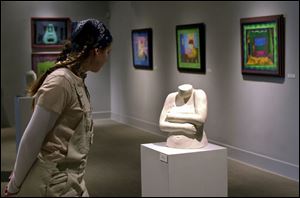
Siena exhibit looks at life after breast cancer
11/27/2001
Sarah Adkins, a junior at Siena Heights University, looks at an exhibit in the display on breast cancer awareness.
ADRIAN - Mike Jones was deeply moved as he stood among the photographs and sculptures of women's bodies.
The bodies were disfigured and had no faces. But each figure represented a woman's fight with breast cancer and the celebration of life after survival.
“Biopsy: Looking at Life After Breast Cancer” is the name of an exhibit on display at Siena Heights University's Klemm Gallery. The exhibit showcases the work of three artists - each touched by the deadly disease.
“It's touching to see someone who can express their feelings,” said Mr. Jones, 43, a fine arts student at the university. “The work beautifully expresses a combination of pain and sorrow, but also the will to go on.”
The exhibit, which runs through Dec. 12, comes on the heels of Breast Cancer Awareness month.
At the door leading to the gallery, small pink ribbons and brochures about cancer greet guests.
Inside, black and white photographs line the walls - each showing a faceless woman's bare breasts and the scars that come with a mastectomy. The pictures, photographed by Amelia Davis of San Francisco, are collected in a book titled, The First Look.
The photographed women offer insights into the struggles that go along with breast cancer and their lives as survivors.
“Sometimes when I look at my scar, I feel sorry for myself and think, `Why me? Why do I have to be a statistical anomaly,'” said Rachel, 28, whose written words accompany a photograph of her scarred chest. “Other times I see the scar as a battle wound, a positive symbol of my survival, perseverance, and strength.”
Alongside the photographs are paintings by artist Hollis Sigler, who recently died of breast cancer after years fighting the disease.
Small clay figures of headless women created by Nancy Fried, a breast cancer survivor, give visitors a three-dimensional and artistic look at the effects of mastectomies.
Klemm Gallery Director Peter Barr said that while the majority of visitors to the exhibit have been women, several men have wandered through the gallery. And when they leave, he hopes they will think of the female form not as an erotic figure but as something that needs to be cared for.
“I hope that this exhibit will take the issue of the breast away from an erotic object, something that is taboo, and make it a subject people feel comfortable talking and thinking about,” he said. “And if they do that, maybe they will be more brave about doing self breast exams and mammograms.”
Despite the nudity and disfigurement, the exhibit is far from offensive, art student Sarah Adkins said. Instead, it shows triumph over adversity and opens the minds of people to the strength of breast cancer survivors.
“I left this show thinking that the effects of breast cancer don't have to be depressing,” said Ms. Adkins, 20. “After looking at the photos and reading the stories, I want to research it more.”